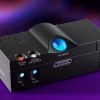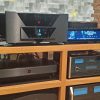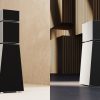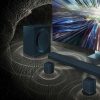I’m old. This, I believe, entitles me to a certain degree of crankiness, through having lived a heckuva long time and accumulated a lot of experience in all things musical, audio, and video. I’m old enough to have followed the evolution of sound reproduction from my childhood in the early 1950s, beginning with low-fidelity mono (one speaker, gang) delivered from a clumsy 3-minute easily breakable shellac disc spinning so quickly you couldn’t read the label (78 rpm records), up to the present ultra-pristine and spectacular digital musical playback of 5.1 or more channels in the home–in fact, in my home! What progress!
Look at the history of sound recording and playback–it’s always moved in the direction of more channels, better separation between the latter, and improved fidelity–the entirely reasonable goal being that more channels of audio information will deliver greater musical and spatial realism. Greater fidelity to what occurs in real, live music.
Resistance to Multi-channel
In recent years, however, as the popularity of 5.1-channel home theater has soared, and multi-channel music formats have proliferated, I’ve become increasingly aware of a certain resistance among some audiophiles–perhaps even a stubborn digging-in-of-heels, to the notion of more than two channels of sound reproduction in the home.This attitude is based on the same kind of illogical and unscientific reasoning that dismisses more than two channels of sound reproduction as being somehow impure or tainted by all those extra channels.
Inherent Limitations
I’ve documented in previous newsletters the intrinsic limitations of stereo, so those who are interested in finding out more need only click on this link. This isn’t to say that stereo doesn’t do a lot of things very well; it does, and when it first appeared, it was a dramatic improvement over mono. For the first time, we had music reproduction with directional instrumental placement, some spatial cues and, on some recordings, even a hint of the recording’s acoustical setting. But the worship of stereo as the pinnacle of high fidelity is peculiar, even eccentric, and, with rare exception contradicts our real-life experience of hearing in all directions.
Of course, everyone can listen in mono, or stereo, but I invite you to try the three-dimensional, more realistic experience of multi-channel audio.
Hearing in all directions
When you hear live music, sounds arrive from a multiplicity of directions. Our remarkably sophisticated hearing is constantly analyzing the time and level (volume) differences of sounds as they arrive at each of our ears (and go around our head, slightly delayed and reduced in strength in reaching the other ear) from all directions. Think about what happens as you walk down a hallway in your home. You hear your feet scuffing the floor from below, the brief faint echoes of your footsteps from the adjacent walls (assuming no carpet), the hum of the refrigerator in the kitchen straight ahead, the muted sounds of cars passing and children playing on the street from behind you as you leave your living room, the ticking of a clock on the wall on your left as you pass it in the hallway, the sound receding as you head for the kitchen. All these directional and spatial cues are impinging on your auditory system, and your brain is making hundreds of calculations per second to let you know the relative placement and direction of those sound sources as well as instant spatial cues to the physical size of the passageway. Stereo cannot convey this information from two channels at the front of your room. (Certain kinds of binaural two-channel dummy-head recordings played on headphones can encode a lot of this information, but that’s a subject for another newsletter.)
However, the good news is that modern multi-channel recording and digital processing can preserve and reproduce virtually all of this sonic information. We presently have enough channels to recreate a highly believable approximation of a live acoustic event. Isn’t that the goal? With mono, we had to listen down a narrow tunnel and use our imagination to interpolate that into a real event. And yes, with a single performer– a young man or woman with a guitar in a dry studio, for example–two channels will deliver much of the information, unless you put her in a recital hall or a different acoustic space. Then the reverberant cues and spatial cues in a stereo recording will only hint at the setting. But record her in 5.1 channels in a concert venue, using three mikes across the front with a couple more suspended mikes back in the hall for ambient pickup, and play it back in 5.1, then you are in the space. The recording opens up; your living room becomes the recital hall.
Retrieving Hidden Spatial Cues
The other excellent news either ignored or never experienced by those worshipful stereo enthusiasts is that if you play a stereo recording in Dolby Pro LogicII, dts Neo:6, or Logic7, the subtle time, level and phase differences present on a lot of stereo recordings will be retrieved, decoded and shunted to the appropriate surround channels, often with a big increase in realism. It isn’t a corruption or adulteration of stereo; it’s the sophisticated application of processing algorithms based on acoustical information that is largely lost in two-channel stereo playback.
There may be other reasons that some audiophiles resent home theater. Perhaps they’ve only experienced a cheesy Home-Theater-in-a-Box system with a boomy inadequate subwoofer, or tiny little cube speakers with miniature cone drivers. This may have been their only impression of “surround sound.” Most of these people have simply never heard really great music playback over 5.1-channel systems and don’t know the potential of two-channel CDs or stereo sources decoded through DPLII, dts Neo6 or Logic7.
The Challenge
Here’s my challenge to all those who still adore two channel playback: Pick one or more of the following recordings, listen to them in stereo, then switch to DPLII or dts Neo:6 (do it at a friend’s place if you lack the associated AV receiver and speakers, or order in a 5.1 system on trial). Accept change, try and listen in an unbiased way. Any of the following stereo recordings played on a carefully calibrated 5.1-channel system in DPLII, dts Neo:6, or Logic7 should astonish and persuade even the most intractable stereo enthusiast that five channels of sound reproduction (plus a subwoofer) deliver a much more realistic and convincing evocation of a real musical experience. They may even grow to love 5.1 playback of music. And if the odd recording doesn’t charm them in 5.1, the surround processing can always be turned off and the playback returned to good ol’ stereo!
Suggested Recordings:
Arnold for Band, Dallas Wind Symphony; Reference Recordings RR-66CD. Try tracks 5, 12, 10 and 21.
These brass, wind, and percussion pieces composed by Malcolm Arnold for brass/wind bands have a lovely presence that puts you in the hall when you switch from stereo to DPLII (Music) dts Neo:6 or Logic7. There’s also a big bass drum with lots of deep bass whomp!
Stan Getz / Charlie Byrd: Jazz Samba; Verve 810 061-2. Start with tracks 1, 2 and 3.
One of the great jazz albums from the 1960s, the mellifluous sax playing of Stan Getz and consummate guitar work by jazz guitarist Charlie Byrd has never been bettered. You still hear this disc playing as background in better restaurants and you’ll like what happens when you go from stereo to 5.1 in any of DPL, dts or Logic7.
Malcolm Arnold Overtures: London Philharmonic Orchestra; Reference Recordings RR-48CD. Tracks 1, 2 and 3.
If music for wind band isn’t your cup of tea, then try these melodic overtures by Arnold. Recorded by “Professor” Keith Johnson, the disc comes alive in DPLII or dts Neo:6. The reverberant hall and bass drum are a knockout.
Babatunde Olatunji: Circle of Drums; Chesky CD/SACD295 (dual-layer). Tracks 1 and 5.
David Chesky has been quietly making wonderful sounding recordings for years, and the drum sounds on this one are simply awe-inspiring, especially if you have a good subwoofer. The disc has a stereo layer, which sounds excellent and decodes wonderfully in dts Neo:6, DPLII Logic7 (H/K or Lexicon). If you have an SACD player, the sound is even more amazing.
The Commitments: Original Motion Picture Soundtrack; MCA MCASD-10286. Track 9 and others.
The R&B arrangements and vocals on this disc, from the excellent movie of the same name, are punchy and good, with especially powerful electric bass. It’s not spectacular when you switch to DPL or dts, just an enveloping opening-up of the sound.
Saint-Saens: Organ Symphony. Montreal Symphony Orchestra, Charles Dutoit, cond. London MCPS 410 201-2.
A fine 1983 recording of the powerful Saint-Saens work that’s musically as satisfying as the old Living Stereo Charles Munch Boston Symphony version and technically a much better recording. Lovely orchestral and pipe-organ sounds that put you in the church when you switch on DPLII, etc.
Jacques Loussier: The Best of Play Bach; Philips 824 664-2. Track 1, 2, etc.
Jacques Loussier is a French jazz pianist with impeccable technique, who does really fine jazz interpretations of Bach keyboard works. The acoustic bass is among the best recorded in my collection and it decodes beautifully in 5.1 via DPLII, dts Neo:6 or Logic7. If you have trouble finding this one, look for The Bach Book: Jacques Loussier Trio, on Telarc CD-83474. The latter recording is excellent as well (track 3, 5).
John Rutter: Requiem; Turtle Creek Chorale, Dallas Women’s Chorus; Reference Recordings RR-57CD. Tracks 1, 4, 5-11.
This richly melodic work for chorus and orchestra by the contemporary composer John Rutter simply opens up and puts you in the hall through DPLII, dts or Logic7. It’s as persuasive and enveloping in 5.1 as it was when I heard Rutter conduct this live in New York’s Carnegie Hall several years ago.





























